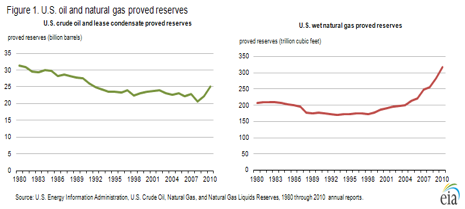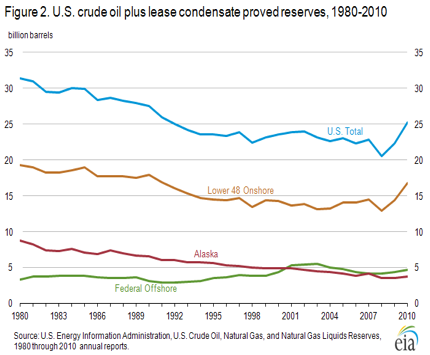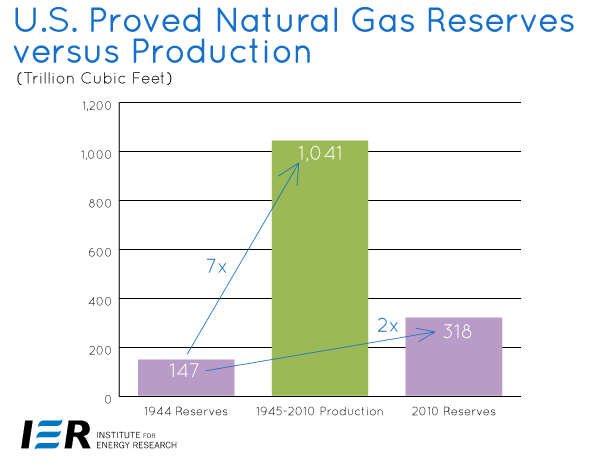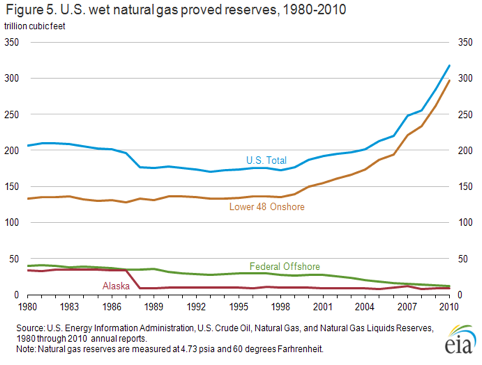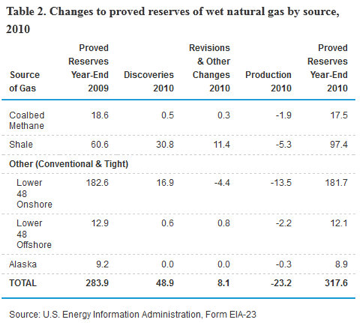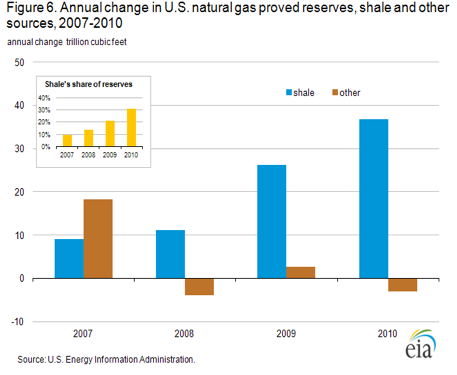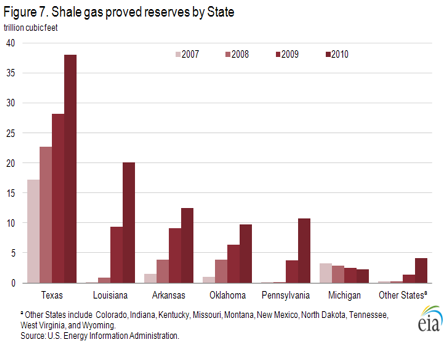The Energy Information Administration (EIA) recently announced that oil and natural-gas proven reserves jumped in 2010 by the highest margin in at least three decades. Proven reserves of crude oil increased by 13 percent (2.9 billion barrels) and proven reserves of natural gas rose by 12 percent (33.8 trillion cubic feet). Oil reserves at the end of 2010 were 25.2 billion barrels and natural gas reserves at the end of 2010 were 317.6 trillion cubic feet– the first time they reached a level over 300 trillion cubic feet. The increases were the highest recorded by EIA since it began publishing the estimates in 1977.[i]
Proven reserves are not the total oil or natural gas resources, but the portion of oil or natural gas resources that can be produced with reasonable certainty, given current economics and existing technology. Higher prices; new, improved technology; new discoveries and more leases available for drilling can increase reserve numbers.
Oil reserves in 2010 increased because sustained higher oil prices made it profitable to do more types of drilling and hydraulic fracturing technology provided access to oil trapped in shale formations (principally in North Dakota and Texas). Texas and North Dakota together accounted for almost 60 percent of the increase in oil reserves. Hydraulic fracturing technology also helped to boost natural gas reserves, allowing natural gas supplies locked in shale-rock formations to be accessed.[ii]
Proved reserves of natural gas began increasing moderately in the late 1990s and grew dramatically after the mid-2000s, along with intensified horizontal drilling programs. Recently, tight oil developments such as those in shale have contributed to the reversal of more than two decades of generally declining U.S. proved oil reserves.
Oil Reserves
Oil reserves at the end of 2010 were 25.2 billion barrels. Proved reserves increased in each of the five largest crude oil and lease condensate areas–Texas, the Gulf of Mexico Federal Offshore, Alaska, California, and North Dakota. Texas had the largest increase, 860 million barrels (16 percent higher than reserves in 2009), primarily from ongoing development in the Permian and Western Gulf Basins in the western and south-central portions of the state. North Dakota reported the second largest increase, 829 million barrels (78 percent higher than in 2009), due to development activity in the Williston Basin (commonly referred to as “the Bakken.”)
Current U.S. petroleum consumption is almost seven billion barrels annually.
Natural Gas Reserves
EIA estimates that natural-gas reserves are now 318 trillion cubic feet, up from the previous estimate of 284 trillion cubic feet. This increase in reserves was the twelfth consecutive annual increase. Natural gas reserves surpassed 300 trillion cubic feet for the first time in 2010. Four of the five largest natural gas states (Texas, Louisiana, Oklahoma, and Colorado) registered net gains, with Louisiana and Texas adding a combined 17.8 trillion cubic feet, over one-half of the overall national increase. Pennsylvania’s proved natural gas reserves more than doubled in 2010, contributing about one-fifth of the overall U.S. increase. Expanding shale gas developments drove the increases in natural gas reserves in 2009 and 2010. Natural gas reserves increased by 28.8 trillion cubic feet in 2009 — 5 trillion cubic feet less than the increase in 2010.
In 2011, we consumed 24.3 trillion cubic feet of natural gas. So the added reserves in both 2009 and 2010 were both higher than our most recent annual consumption. In fact, between 1945 and 2010, we produced 7 times the amount of natural gas than we had proven reserves in 1944 and still had over twice that amount of proven reserves left in 2010. (See graph below.)
The significance of shale developments can be seen by calculating the share of shale gas relative to total U.S. natural gas proved reserves. The share has increased steadily, from less than 10 percent in 2007 to over 30 percent in 2010.
Texas had the largest increase in natural gas proved reserves in 2010 (9.3 trillion cubic feet), driven by continued development and production at the Barnett and Haynesville/Bossier shale formations. Louisiana increased its total proved natural gas reserves by 8.5 trillion cubic feet due to drilling programs at the Haynesville shale formation, which increased by 10.8 trillion cubic feet, offsetting declines from non-shale sources. Pennsylvania increased its proved natural gas reserves by 7.1 trillion cubic feet due to expanding drilling programs at the Marcellus shale formation. The 7.1 trillion cubic feet increase more than doubled year-end 2009 volumes there. Other key shale states are Arkansas (the Fayetteville shale play) and Oklahoma (the Woodford shale play). Nearly all (96 percent) of the country’s shale natural gas proved reserves in 2010 came from the six largest shale plays, with the Barnett ranked as the largest shale gas play in the United States.
Technically Recoverable Resources
While these increases in proven reserves indicate the potential of our domestic oil and gas resources at prevailing economic and technological conditions, the United States has vast amounts of technically recoverable oil and natural gas that can eventually be classified as reserves if government policies would allow it. In IER’s North American Energy Inventory report based on government resource assessments, we estimated the U.S. technically recoverable oil resources at 1.442 trillion barrels, 57 times more than EIA’s current proven reserve number for oil, and over 200 years worth of oil at current consumption rates. And, for natural gas, we estimated technically recoverable U.S. natural gas resources at 2.744 quadrillion cubic feet, almost 9 times higher than EIA’s natural gas proven reserve number, and over 110 years worth of natural gas at current consumption rates.[iii]
Conclusion
The United States has vast amounts of oil and gas resources, many of which are on federal lands owned by the U.S. taxpayer. Studies have shown that development of these resources along with importing oil and natural gas from our NAFTA partners can make us independent of overseas oil and gas within 15 years.[iv] Of course, access to the resources and a favorable leasing and permitting environment are needed. As these EIA reserve numbers show, the United States can increase its oil and gas reserves, and with it the jobs and economic growth that accompany more energy production. As EIA Administrator Adam Sieminski said in testimony prepared for a House of Representatives hearing, “These reserves increases underscore the potential of a growing role for domestically produced hydrocarbons in meeting both current and projected U.S. energy demands.”
[i] Energy Information Administration, U.S. Crude Oil, Natural Gas, and Natural Gas liquids Proved Reserves, August 1, 2012, http://www.eia.gov/naturalgas/crudeoilreserves/
[ii] Wall Street Journal, U.S. Oil Reserves Jumped in 2010, August 1, 2012, http://professional.wsj.com/article/SB10000872396390443545504577563511346753908.html?mg=reno64-wsj
[iii] Institute for Energy Research, North American Energy Inventory, December 2011, http://www.energyforamerica.org/wp-content/uploads/2012/06/Energy-InventoryFINAL.pdf
[iv] Wood Mackenzie energy consulting, U.S. Supply Forecast and Potential Jobs and Economic Impacts (2012-2030), September 7, 2011, http://www.api.org/Newsroom/upload/API-US_Supply_Economic_Forecast.pdf


